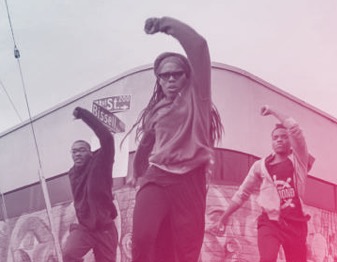From the edge of the Castro, looking down Market Street at dusk, Market almost looks beautiful with its streetlights, trees, and brick sidewalks. But it is not a street I try to linger on. Tourists and high-end shoppers, drug addicts and commuters can be a potent mix. Market’s never been ignored, though it’s certainly seen better days. And lately, it’s been getting just a bit more attention. We’re mid-way through the ban on private cars, the ballot initiative to allow billboards on certain blocks to raise money for the area is coming up in a couple weeks, and last weekend the San Francisco Arts Commission, along with a couple other city agencies and Triple Base gallery launched its first Art in Storefronts show, on Market between 5th and 7th.

“Giant Ghosts” (photo credit: Paul Hayes)
Art in Storefronts, which, by the end of the year will also include art installed in empty storefronts in the Tenderloin, the Mission, and the Bayview, makes sense: local artists get visibility and recognition, empty storefronts look better than they did before, and maybe some people will visit (and linger in) neighborhoods they wouldn’t have otherwise. The best pieces really take advantage of the setting, using the storefronts like dioramas, adding to the street scene and being inspired by it. Paul Hayes‘s “Giant Ghosts” is made of crumpled pieces of paper strewn around and hung up to take the form of huge figures swaying in soft light. The giant ghosts seem benevolent. They feel removed from the hectic street, even though they’re rustling and looming nearby. The effect draws onlookers into their quiet world.

“Don’t Give Up the Ship” (photo credit: SFAC)

“Don’t Give Up the Ship” (photo credit: Josh Ellingson)
Across the street from those dimly-lit piles of paper, Alexis Amann and Jonathan Burstein‘s “Don’t Give Up the Ship” glows from a smaller storefront. A blacklight mermaid and diver float in a neon underwater world, echoing the psychedelic posters of San Francisco’s past, and referencing our present and future of rising sea levels and the ongoing foreclosure crisis. A block down, in Liz Maher‘s “No One Seems to Care That I Want Roots,” Victorian row houses reach out and cling to hills as they’re pulled up into pillowy clouds. Trying to hold on to location and time, they’re forced into movement and change.



